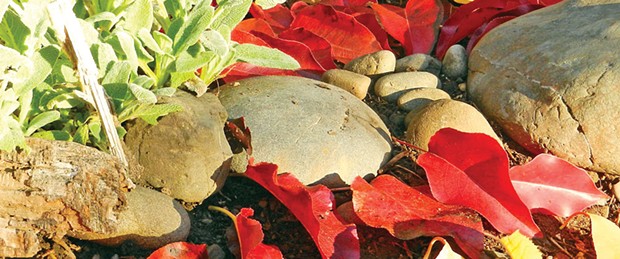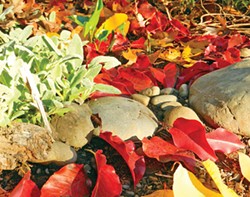[
{
"name": "Top Stories Video Pair",
"insertPoint": "7",
"component": "17087298",
"parentWrapperClass": "fdn-ads-inline-content-block",
"requiredCountToDisplay": "1"
}
]
It's that wonderful time of the year when leaves are falling, plants are decomposing and moisture is in the air. A perfect time for mulching! There is never a bad time for mulch, but with so much surplus organic matter available, it makes sense to harness those resources and use them to warm and protect your garden for the winter.
Mulch builds humus. The word "human" comes from the same roots as humus, meaning earth, and in fact our bodies do contain many of the same elements and microorganisms as fertile organic soil. Soil health is linked to our own health, and soil communities bear remarkable resemblance to the flora and fauna in our own guts. A diverse, thriving intestinal community keeps us humans healthy, and the same goes for the soil ecosystem.
A layer of mulch, whether up around perennials and fruit trees or as a cover for next year's vegetable beds, serves several important purposes. Mulch covers topsoil, keeping it dark and moist, which encourages soil organisms to come to the surface where they eat, breed and poop. Mulch provides habitat for worms and larger insects that travel across the garden in search of shelter. If they find your mulch, they'll move in, further increasing your soil diversity and in turn, garden health. All of this micro-activity is akin to having a teeny-tiny compost machine that cultivates every inch of your soil, increasing organic matter and aeration and building a nutrient-rich foundation for the garden.
Mulch retains water. It acts as a sponge, soaking up the rainfall and slowly releasing it into the soil below. Larger mulch piles can be shaped into mini-berms and used to direct water away from the storm drain and back onto your site. Or dig small swales — shallow trenches on contour — and fill them with a thick mulch to create water-retaining borders all around the garden.
Mulch keeps plant roots warm, which is especially helpful for those varieties that do OK in Humboldt but would probably prefer a slightly warmer climate, like pomegranate, lemon, bananas and many fancy flowering bulbs. For these plants, I like to use larger rocks and river gravel under a leaf mulch. The rocks retain heat, the leaves insulate. But be careful not to pile the leaves too high up the trunk because they can cause rot. Focus on warming the roots just below the soil surface, spreading out from the plant.
In addition to rocks and leaves, there are several other types of mulch that are easily found in the area. Straw bales can be purchased at any farm store, or try the fairgrounds after an event — they often use bales for temporary seating and in parking areas, and you might be able to get them for free. I like a thick cover of straw mulch over the top of my compost pile and on vegetable beds. I am not crazy about the aesthetics of straw, however, and so I don't tend to use it on perennial beds. It does make a wonderful insulator, because each of those little pieces of straw is a hollow tube filled with air that gets warmed by the slow decomposition. Excellent for covering garlic beds over winter, or around winter brassicas. Don't use hay! Hay is green and has tons of grass seeds that will grow all over your garden! Make sure you ask for "straw."
Cardboard and newspaper can be good options for mulching larger areas, especially if you want to kill grass or weeds. Peel the mulch off in the spring and dig beds, or cover the paper mulch with a thick layer of organic matter (leaves, straw, wood chips, or a blend of them all) and plant right into it. Be careful that you don't mulch over bindweed or Bermuda grass, though — it won't kill them and they'll make a thick mat underneath that will choke out your plant roots later.
Wood chips, sawdust and bark can be beautiful under perennials, but they can be expensive to buy. You can sometimes find free sawdust at a local wood shop. I like to use it for blueberries and strawberries, because they love that extra acid. You can also get free wood chips through www.chipdrop.in, where you can register your house, indicate what type of chips you prefer, and make yourself available as a drop site for local tree services that need to dump their shredded surplus.
A final word of warning: Some mulches, especially straw and leaves, can harbor slugs and snails. So watch out for that, especially around baby vegetable plants. Next month, I'll discuss natural ways to deter these slimy pests. Until then, happy mulching!
Heather Jo Flores wrote Food Not Lawns, How to Turn Your Yard into a Garden and Your Neighborhood into a Community. Visit www.heatherjoflores.com.
more from the author
-
Tales from the Underground
A rainbow of roots from around the world
- Sep 21, 2017
-
Hashtag, Bumper Crop
Veggies to plant now for fall and winter
- Aug 17, 2017
-
Plotting Out Your Garden: Part 2
- Apr 6, 2017
- More »


































